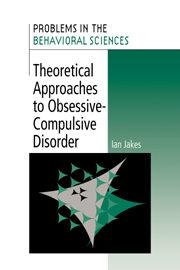Book contents
- Frontmatter
- Contents
- Dedication
- Synopsis of Theoretical approaches to obsessive-compulsive disorder
- Acknowledgments, and provenance of Theoretical approaches to obsessive-compulsive disorder
- 1 The natural history and definition of obsessive-compulsive disorder
- 2 Behavioural/learning accounts of OCD
- 3 Accounts of OCD based upon personality theories derived from the work of Pavlov
- 4 Janet on OCD
- 5 Psychodynamic approaches to OCD
- 6 Cognitive style/deficit approaches to OCD
- 7 Biological approaches to OCD
- 8 Concluding remarks
- References
- Author index
- Subject index
1 - The natural history and definition of obsessive-compulsive disorder
Published online by Cambridge University Press: 07 May 2010
- Frontmatter
- Contents
- Dedication
- Synopsis of Theoretical approaches to obsessive-compulsive disorder
- Acknowledgments, and provenance of Theoretical approaches to obsessive-compulsive disorder
- 1 The natural history and definition of obsessive-compulsive disorder
- 2 Behavioural/learning accounts of OCD
- 3 Accounts of OCD based upon personality theories derived from the work of Pavlov
- 4 Janet on OCD
- 5 Psychodynamic approaches to OCD
- 6 Cognitive style/deficit approaches to OCD
- 7 Biological approaches to OCD
- 8 Concluding remarks
- References
- Author index
- Subject index
Summary
Introduction and natural history
It is quite common for books on obsessive-compulsive disorder (OCD) to open by offering a brief definition of the disorder. Because the definition of OCD is to be treated here as a major issue in its own right, such an introduction is not possible. Instead, a few examples of symptoms reported by OCD patients are offered. A fuller picture of the symptoms reported by these patients will be provided by the discussion of the definition of the disorder later in this chapter. All the following examples are taken from de Silva (1988, pp. 196–7):
(a) thought plus… [mental] image [of the patient's having] knocked someone down with his car
(b) impulse…to shout obscenities during prayer or a church service
(c) [mental] image of corpses rotting away…
(d) repeated and extensive washing of hands to get rid of contamination by germs
(e) checking gas taps, door handles, and switches three times [whenever the patient] went past them
(f) imagining in sequence…photographs of members of [the patient's] family, his parents, pictures of Jesus Christ and the Virgin Mary, and then photographs of two other persons
Chapters 2 to 7 will review a variety of theoretical approaches to OCD. Although a diversity of work will be covered by this review, including behavioural, cognitive, psychodynamic, and biological approaches to the disorder, the review will not aim to be exhaustive. In particular, it will omit detailed consideration of such important elements as the interesting relationship between OCD and depression (Stengel, 1945; Lewis, 1934), and the phenomenological approach of Schneider (1925), whose classic work on personality disorders includes a discussion of obsessionals, termed by him insecure psychopaths.
- Type
- Chapter
- Information
- Publisher: Cambridge University PressPrint publication year: 1996
- 1
- Cited by



